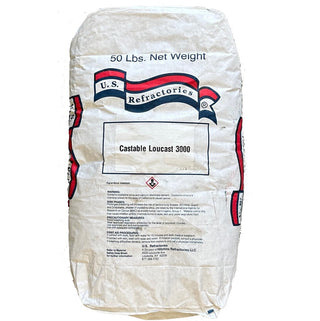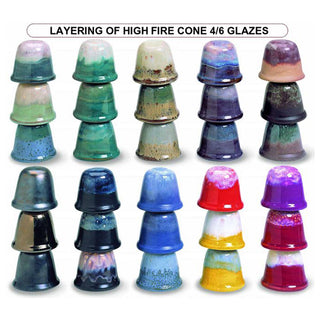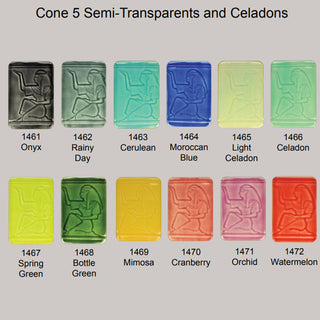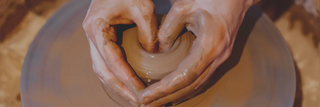LOUCAST 3000 Degree Dense Castable Refractory Mortar
Cast Your Own Hard Fire Brick
Loucast is a dry material offered here in 50 pound bags. You add water, mix and pour into your form to create a dense high-temperature firebrick. The finished product is rated at 3000F. This material is often used in furnaces and boilers. It is often used to create forges and for the floor of pizza and bread ovens. For wood kiln building this a great product as it allows you to cast any shape you need.
When casting larger monoliths it is recommended to add stainless steel refractory needles or other or stainless wire reinforcement.
We also carry Litewate which is a similar product but with Litewate you can cast insulating firebrick forms.
Often a forge will utilize a dense (Loucast or hard-fire brick) floor, with walls made of or insulated with Litewate, soft insulating fire brick (IFB), or kaowool blanket.
All of these materials are available in pallet quantities at special pricing for large scale projects. Please call or email us for a quote.LOUCAST 3000 Degree Castable Refractory is a dense castable refractory mortar rated for 3000˚F It is low iron content, with high purity. This refractory mortar is designed to successfully withstand high sulphur fuel, reducing atmospheres, carbon deposition, erosion and abrasion. This castable refractory cement can be used for gunning, casting, troweling, or extruding.
Yield:
131 Pounds dry yields 1 cubic foot.
50 pound bag yields approximately 0.38 cubic feet
Mix Rate: 4.8 quarts / 100 Pounds
Installation
The installation procedures for castables are relatively simple if the fundamentals are understood. With proper supervision, relatively unskilled labor can be used and still achieve excellent structural and thermal properties in the finished refractory lining.
Mixing
Castable refractories or refractory concretes, as they are sometimes called, can be installed by one of several methods: (1) pouring into forms, (2) tamping into place or (3) pneumatic gunning. When the installation is by pouring or tamping, the mixing is done in a concrete mixer or preferably in a paddle type mixer. Mixing can be done in a mortar box by hand but this is not recommended. Only good clear water, suitable for drinking, should be used because there could be mineral or chemical contaminants in process water or dirty water, which could completely destroy the effect of the bonding agent in the refractory. The mixer must be free of dirt and set-up concrete from previous mixes because if this material were to flake off into the new castable, it could have a radical effect on the setting characteristics of the new material.
The time of mixing, after the addition of water, should be sufficient to insure that all of the dry material is thoroughly wetted but in no case should exceed five minutes.
The proper water to cement ratio is of extreme importance when mixing a castable refractory mortar. Enough water has to be used to hydrate the cement but an excessive amount of water will create shrinkage and a considerable loss of strength. There is a natural tendency for workmen to make the castable refractory mortar mix too wet because it will work and flow more easily in this state. As a result it is important to maintain careful supervision over the mixing process and there should be little variation in the water to material ration from the batch to batch.
There is a simple test, called the ball-in-hand test, to determine the proper consistency.Take a large handful of the castable refractory mortar mix and squeeze it between the hands as if making a snowball. The material should form compactly and have a light film of water on the surface. When the ball is thrown about 12 inches into the air and caught with an open hand, the material should slump only enough to just begin to penetrate between the fingers. A mixture of this consistency would be correct for what is normally called a pouring mix.
A tamping mix, by the same test as described above, should have just enough water to form a compact ball with no water film on the surface. When thrown as above it should remain intact and not penetrate between the fingers at all. The temperature during mixing and casting is mainly of importance due to its effect on the working time. Castables are stronger when cast in the warm weather, 70 degrees Fahrenheit or above, but casting at temperatures as low as 40 degrees Fahrenheit generally gives good results if the castable is not allowed to freeze before it cures. In cold weather it is advisable to keep the castable stored in a warm place and even to use warm water for mixing so that the temperature of the mixture at the time of the pouring is around 70 degrees.
Placement and Working Time
The castable refractory mortar mixture should be poured into place immediately upon completion of the mixing cycle. The use of a pencil vibrator is recommended to consolidate the material and to help remove entrapped air. However, caution must be exercised to avoid over vibrating which will cause water and cement to migrate to the surface and create a weaker structure.
Immediately upon the addition of water to a castable refractory mortar, hydrates begin to form, which will eventually cause the mix to set. This setting process occurs in two steps:
INITIAL SET: The castable becomes stiff, but not hard. The placing of the material must be completed before this stiffening occurs. The time available between the addition of water and this initial set is dependent on temperature, type and amount of castable. In warm weather the initial set occurs 10 – 20 minutes earlier than in cold winter weather. Therefore, in the summer the working time of low and intermediate purity castables are 30 – 40 minutes and that of high purity castables is 20 – 30 minutes.
FINAL SET: The hardening of the castable refractory mortar is accompanied by the evolution of heat. This is the final set and occurs during the curing process.
Hydraulic setting castable refractory mortar requires 24 hours to develop their full strength. The strength depends entirely upon the formation of the proper type and amount of hydrates and thus during the curing process plenty of water should be available to insure the conversion of the dry cement to hydrated cement. During casting, about twice as much water is added to the castable as is needed for full hydration. Therefore the trick is to keep the water in place. If proper precautions are not taken the heat generated by the hydration reaction, especially in thick sections, will evaporate the water before all of the cement is hydrated.
Some helpful suggestions :
Be sure that the forms used are waterproofed with a good coating of oil or paint. (This is not necessary with metal forms, however a light coating of oil or grease on metal forms will help with mold removal.)
Seal the surface of the castable with a waterproof coating, called a membrane curing
Keep the surface wet with water sprays to replace the evaporated water or for small installations cover with wet bags.
Note: If water spray is used, be sure not to apply it until the mix is set enough so that the surface will not wash. This can be checked by gently rubbing with a wetted finger. I the finger remains clean the castable is set enough to apply light water spray.
The fact that the castable refractory mortar gets hot as a result of it’s own heat generation during curing is not important. It is not heat but humidity that is the controlling factor. Heat evolution generally starts 3 – 12 hours after casting and is 90% complete after 24 hours. At this point the molds can be removed and the dry out process started.
As installed, most castables are very dense and have extremely low permeability. As a result it is very difficult for moisture and vapor to escape. If the heat-up rate is too rapid, tremendous steam pressures can build up inside the lining, even to the point of explosive spalling. But even short of the point of explosive spall, enough pressure can be generated to cause unseen flaws within the lining, which can severely limit the working life of the castable. Therefore dry out and initial heat-up methodology is very important.
As cured most castable refractory mortars contain about 10% total water. Approximately 50 – 75% of this water is free water while the remainder is chemically bound. The free water has to be removed during air-drying and for a period of time at 230 degrees Fahrenheit. Actual dry out schedules depend upon the thickness of the castable, ventilation possibilities, etc. When casting against a metal shell, weep holes should be drilled in the shell to facilitate moisture escape. The castable should be allowed to air dry 24 hours before any heat is applied.
Heat Up
When the castable is properly dried it still contains 2.5 to 5.0% water, which is chemically bound to the cement. This water is removed at various temperatures but the majority comes off about 500 – 600 degreed Fahrenheit. For this reason it is recommended that the temperature be increased at the rate of 50 degrees Fahrenheit per hour to 1000 degrees Fahrenheit with a hold at 600 degrees for one hour per inch of lining thickness. After reaching 1000 degrees Fahrenheit the heating rate can be increased up to 100 degrees Fahrenheit per hour until operating temperature is reached.
No hard and fast heating schedule can be prescribed for all installations. It is dependent upon the mass and type of material installed and various other conditions. Obviously a suspended roof that is exposed top and bottom for the escape of moisture could be heated more rapidly than a wall, which is backed up with insulation and a steel casing.
A typical safe heating schedule for an AVERAGE installation is given below:
Raise the temperature gradually to 230 degrees Fahrenheit and hold for twelve hours.
Raise the temperature at 50 degrees Fahrenheit per hour to 600 degrees Fahrenheit and hold for one hour per inch of lining thickness.
Continue to raise the temperature at 50 degrees Fahrenheit per hour to 1000 degrees Fahrenheit then 100 degrees Fahrenheit per hour to operating temperature.
The above temperatures are based on the hot face of the castable refractory mortar. Heat-up should be continuous and uninterrupted. If excessive steaming occurs hold but do not drop the temperature until the steaming is subsided.
Order your castable refractory materials from Sheffield Pottery.
Please feel free to contact us for special pricing for large scale projects!
CUSTOMER REVIEWS - Q&A
Got a question about this product? Ask it here and get a response from our staff and also input from the Sheffield Pottery community!










